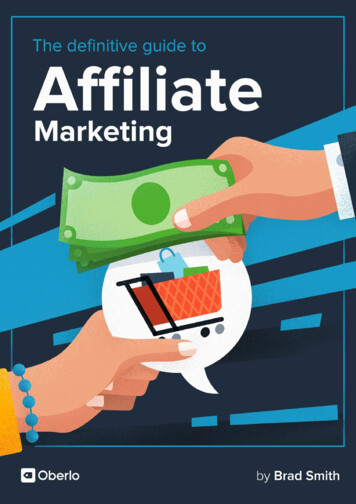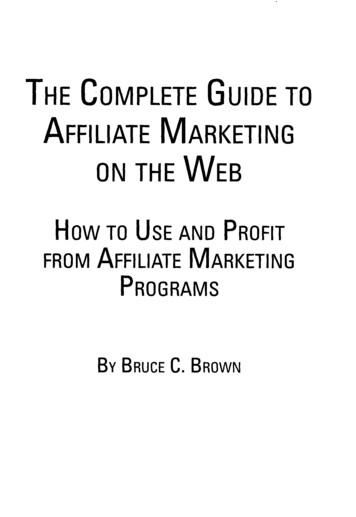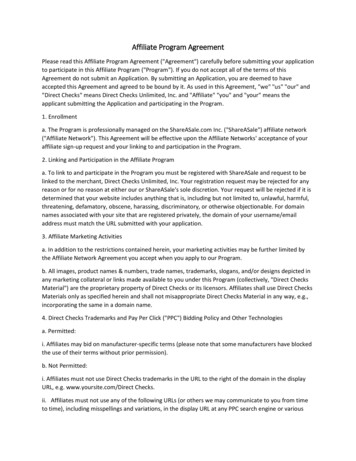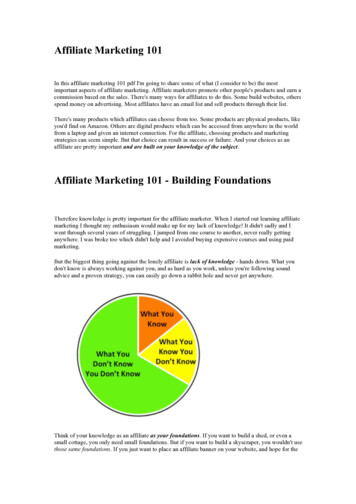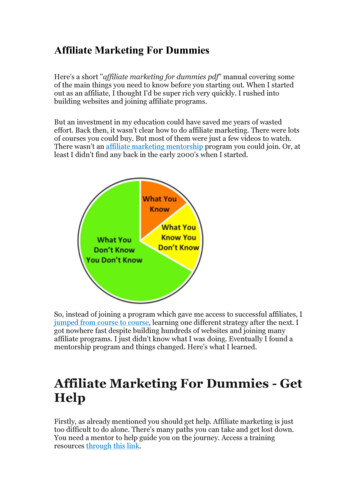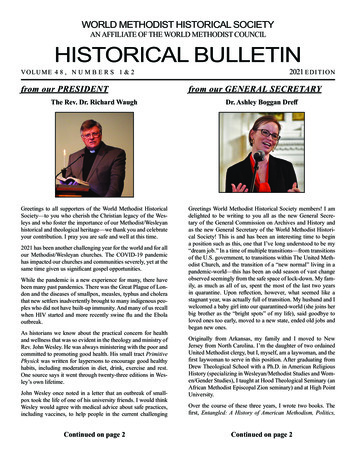
Transcription
WORLD METHODIST HISTORICAL SOCIETYAN AFFILIATE OF THE WORLD METHODIST COUNCILHISTORICAL BULLETINVOLUME 4 8 , N U M B E R S 1 & 2from our PRESIDENT2021 E D I T I O Nfrom our GENERAL SECRETARYThe Rev. Dr. Richard WaughDr. Ashley Boggan DreffGreetings to all supporters of the World Methodist HistoricalSociety—to you who cherish the Christian legacy of the Wesleys and who foster the importance of our Methodist/Wesleyanhistorical and theological heritage—we thank you and celebrateyour contribution. I pray you are safe and well at this time.Greetings World Methodist Historical Society members! I amdelighted to be writing to you all as the new General Secretary of the General Commission on Archives and History andas the new General Secretary of the World Methodist Historical Society! This is and has been an interesting time to begina position such as this, one that I’ve long understood to be my“dream job.” In a time of multiple transitions—from transitionsof the U.S. government, to transitions within The United Methodist Church, and the transition of a “new normal” living in apandemic-world—this has been an odd season of vast changeobserved seemingly from the safe space of lock-down. My family, as much as all of us, spent the most of the last two yearsin quarantine. Upon reflection, however, what seemed like astagnant year, was actually full of transition. My husband and Iwelcomed a baby girl into our quarantined-world (she joins herbig brother as the “bright spots” of my life), said goodbye toloved ones too early, moved to a new state, ended old jobs andbegan new ones.2021 has been another challenging year for the world and for allour Methodist/Wesleyan churches. The COVID-19 pandemichas impacted our churches and communities severely, yet at thesame time given us significant gospel opportunities.While the pandemic is a new experience for many, there havebeen many past pandemics. There was the Great Plague of London and the diseases of smallpox, measles, typhus and cholerathat new settlers inadvertently brought to many indigenous peoples who did not have built-up immunity. And many of us recallwhen HIV started and more recently swine flu and the Ebolaoutbreak.As historians we know about the practical concern for healthand wellness that was so evident in the theology and ministry ofRev. John Wesley. He was always ministering with the poor andcommitted to promoting good health. His small tract PrimitivePhysick was written for laypersons to encourage good healthyhabits, including moderation in diet, drink, exercise and rest.One source says it went through twenty-three editions in Wesley’s own lifetime.John Wesley once noted in a letter that an outbreak of smallpox took the life of one of his university friends. I would thinkWesley would agree with medical advice about safe practices,including vaccines, to help people in the current challengingContinued on page 2Originally from Arkansas, my family and I moved to NewJersey from North Carolina. I’m the daughter of two ordainedUnited Methodist clergy, but I, myself, am a laywoman, and thefirst laywoman to serve in this position. After graduating fromDrew Theological School with a Ph.D. in American ReligiousHistory (specializing in Wesleyan/Methodist Studies and Women/Gender Studies), I taught at Hood Theological Seminary (anAfrican Methodist Episcopal Zion seminary) and at High PointUniversity.Over the course of these three years, I wrote two books. Thefirst, Entangled: A History of American Methodism, Politics,Continued on page 2
(Waugh continued from page one)(Dreff continued from page one)situation around the world. His rules for Christian living areboth simple, profound and relevant in a quote often attributedto him, “Do all the good you can, By all the means you can, inall the ways you can, in all the places you can, at all the timesyou can, to all the people you can.”and Sexuality, examines the oft-intertwined relationship between United Methodism, American politics, and conversations surrounding the ever-complex notion of human sexuality.The second, Nevertheless: American Methodists and Women’sRights, examines how (United) Methodists in America have advocated for women’s rights both within the American federalgovernment and (United) Methodist denominations.Wesley would also counsel that the essence of being holy, orsanctified, is to walk closely with God and with humankind(Hebrews 12:14). Perfect love is about fully loving God andfully loving our neighbours, including times of extending graceand compassion to those facing disease. Christians—includingthose in the Methodist/Wesleyan stream of the church—havealways been prominent in such practical support and love. Mayit continue to be so.If I’ve learned anything over this last year, it’s that there is nogoing back to normal after COVID-19. We’re all in this state oftransition together and what the outcome looks like is yet to bedetermined. For now, let’s focus on transitioning into a worldthat is more equitable for all, one that values history and thehumanities, one that truly lives into our Wesleyan mandate todo no harm and do good.While the World Methodist Conference has been postponedto August 2022, we continue to work in our own spheres ofresponsibility and belonging. We continue to influence others through the promotion of Methodist/Wesleyan history andtheological emphases.Things aren’t the same at GCAH, either. We’ve been in an almost constant state of transition. Here’s a snippet of changesthat are being implemented as we speak:We spent the first six months of 2021 creating new types of resources for this year’s Heritage Sunday. Our theme was “Pride,Shame, and Pain: Methodist History with Racism and Effortsto Dismantle It” 1). Exploring United Methodism’s history of racismbegan under my predecessors, but I intend to keep GCAH focuson the work of anti-racism through an honest, open, and complete account of how Methodists have been complicit in sustaining and dismantling racism in our denomination(s). If youhaven’t already, please explore our workbook (and whole hostof other materials), designed for individual, congregational,and group study use. The resources produced up until this pointhave reflected upon anti-Black racism and are currently beingexpanded as we research American Methodists’ roles in indigenous boarding schools. Part of this work will be the launch ofan oral history project, aimed at identifying, collecting, preserving, and promoting the histories of racial/ethnic minority United Methodists. So many of the resources that archives rely onare written records, and too often, the written record presents awhite, Euro-centric reading of history. In order to preserve andpromote the full story, we must diversify our collections. Manyracial/ethnic communities rely on oral histories and storytellingto keep tradition alive. It’s my hope that through an oral historyproject, we’ll set the stage for future historians to begin to tella more complete story, one that is told from new, diverse pointsof view.As mentioned last year in my South Pacific/New Zealand context, 2022 will be a key year to recognise and celebrate 200years since the first Wesleyan mission was established by missionary Rev Samuel Leigh. We look forward to some specialoccasions, although sadly the John Wesley family of churchesin Aotearoa New Zealand are fragmented and often don’t worktogether.In my location in the eastern part of Auckland city (populationof 1.5m), I am chairman of the Howick & districts 175th anniversary community committee as we commemorate 175 yearssince the first settlers arrived. Fortunately, the relationship withMaori was harmonious in the late 1840s with Maori helping toprovide necessary food and shelter to the Fencible families whohad come from the demanding conditions of Ireland and England. See our website at: www.howick175.co.nz. I am alwaysa strong advocate for the proper promotion of history, and especially in the local context where we live. Here in East AucklandAnglican, Wesleyan Methodist and Roman Catholic churcheswere inextricably involved in the early days of settlement, sothere is plenty of scope for church and wider community interaction.In this bulletin we welcome Dr. Ashley Boggan Dreff sharingwith us. Thank you to all others who have contributed to thenews and updates in the bulletin.We are incredibly excited about our new podcast, Un-TiedMethodism,” wBE) where we unravel the past to make sense oftoday, which is available via Spotify and Apple Podcasts. Sofar, we’ve released over a dozen episodes with more in production each month. These 45-minute episodes offer me and ourlisteners a chance to hear from some of the top scholars in thefields of Methodist history and religious history, to hear frombishops throughout our denomination, and prominent churchleaders. We’ve explored everything from racism and colonialism to Welch’s Grape Juice! Subscribe to this podcast in orderGrace and Peace,Rev. Dr. Richard Waugh QSMAuckland, New Zealand-WMHS-2
to follow along as we examine the roots of the UMC (and itsantecedent denominations) to understand why the UMC is theway that it is and maybe figure out where we might be going.try, with the ups and downs of social and economic needs—likethe financial crisis of 1929, which nearly ruined the successesof the community. By the time the 1950s rolled around, therewas a critical mass of visitors, supporters, and full-time residents, which brought a greater sense of permanent community. It was within this environment and context that the WorldMethodist Council and Rev. Clark were able to coalesce aroundthe interests of shared global histories.GCAH is also currently doing a brand refresh in light of ournew website launch next year! We’re in the process of designing a website that is much more user-friendly, more interactive,and modern. In line with this process, we’ll be producing digitalexhibits and online courses to find new ways to engage with allfrom a distance!The vision of Rev. Clark finally came to fruition in the form ofthe World Methodist Council Museum. As one of the first General Secretaries (along with Dr. E. Benson Perkins) of the WorldMethodist Council, he had considerable foresight and intuitionabout history, both the preservation of the church’s heritageand the presentation of its legacy into the future. With this, theWorld Methodist Museum was born. The expansive contentsof the museum grew after its founding and Clark’s contributions and stewardship. Margaret McCleskey, daughter of thelate superintendent of Lake Junaluska Assembly, Dr. James W.Fowler, Jr., whose tenure ran between 1953 and 1966, had spentmany summers in high school and college there. Now morethan half a century later, she fondly recalls Rev. Clark and hisfamily, who were their neighbors, while she and her parentsstayed in the Atkins House. Retired Rev. D. Michael Jordanworked as a teenager for Rev. Clark and recently noted at thefinal meeting in Lake Junaluska of the Friends of the WorldMethodist Museum that Clark was a vibrant personality whohad great energy and endless ideas.As all transitions involve working out some of the kinks thatpop up along the way, the above transitions will not be perfect.Like good Wesleyans, we will constantly and continuously seekperfection (but probably never achieve it). Feel free to reach outto us and stay in touch!Ashley Boggan Dreff, Ph.D.General SecretaryGeneral Commission on Archives and History-WMHSThe World Methodist MuseumArrives in Dallas, Texas, July, 2021Bridwell Library Receives the Collectionsfrom Lake Junaluska, NCRev. Lee Tuttle followed Clark and Perkins as the next GeneralSecretary of the Methodist World Council, serving in that position from 1961 to 1966 along with the British representativeRev. Max W. Woodward, and then as the sole Secretary until1976. One of Tuttle’s most significant enhancements was theSusanna Wesley Garden, adjacent to the museum buildings. Hecreated the garden in honor of the matriarch, often called the“Mother of Methodism,” whose sons John and Charles wereprogenitors of the denomination. The garden slopes down toward Lake Junaluska and is nestled into a quiet and secludedniche of earth with an outdoor chapel for people to seek solacein reflection, meditation, and prayer.By Anthony J. EliaDirector of Bridwell LibraryThe lifecycle of a museum is a complex and nuanced process,perhaps as much as any living organism. Back in March ofthis year, during my first trip to the calming and bucolic scenesof western North Carolina, I beheld a stoic and commandingbuilding on the hillside that overlooked the majestic watersof Lake Junaluska. The building was the home of the WorldMethodist Museum, which had been there for the prior six-anda-half decades, situated there as the dream realized by the Rev.Elmer Talmage Clark (1886–1966). At the time of the museum’s establishment in 1956, there were luminaries who flockedto the mountain and lakeside retreat, gathering under the cordialand honorable devotion to a Christian unity and considerationof preserving and maintaining the vast cultural heritage of theMethodist Church writ large. Billy Graham, Richard Nixon,and President Eisenhower attended, a feat that would certainlynever repeat itself. Such a gathering speaks to the value andcommitments that the church must have held in the 1950s, butalso to the contrasting notions of what role anything religiousplays in our world today in respect to that of more than half acentury ago.The collections of the museum also grew at this time to encompass other global contributions, including items related to theWorld Methodist Peace Prize, awarded to luminaries like Nelson Mandela, Jimmy Carter, and Mikhail Gorbachev. Additionally, the history of Catholic-Methodist relations is representedin the museum through the historical connections Tuttle andother Council leaders had with Popes John XXIII and Paul VI.The global and the local evolved exceptionally well togetherat Junaluska, as is evident in many items in the museum’s collections. The leadership of the Methodist World Council andthe museum has continued with Tuttle’s successors as GeneralSecretary—Rev. Dr. Joe Hale (1976–2001), Rev. Dr. GeorgeFreeman (2001–2011), and current Secretary Bishop Ivan M.Abrahams. Each of these remarkable leaders has shepherdedthe museum within an ever-changing world, balancing the workof the church with the curatorial and historical challenges ofpreservation, exhibition, and engagement with the public. TheLake Junaluska was founded as a Methodist retreat more thana century ago and developed into a cultural and religious pilgrimage site for lay and clergy alike, where communities ofthe faithful would gather, break bread, worship together, andfeel replenished in body, mind, and spirit. The evolution of thecommunity in Lake Junaluska echoes the growth of this coun-3
current director of the World Methodist Museum and CouncilHeadquarters Coordinator, Jackie Bolden, and communicationsmanager Michaela Bryson have been invaluable assets to theorganization during the last few years. And the longstandingefforts and contributions of the Friends of the World MethodistMuseum have sustained and nourished the museum over thedecades. Its many members have been the heart of its successes and the care and pride in the museum was demonstrated bythose who attended the transition ceremony on April 15th, withPresident Terry Bevill giving honor and praise to the legacy ofthe museum and all those who supported it during these manyyears.manuscript letters of John Wesley, establishing Bridwell asone of the two preeminent centers in the world holding JohnWesley’s hand-written letters. It brings a traveling pulpit usedby John Wesley himself. It brings treasures from Methodismthroughout the globe, and artifacts that illustrate Methodism onthe ground and with ordinary folks: portraits, hymnals, ceramics, and other artifacts.”Indeed, Bridwell Library is exceedingly grateful and honoredto be the recipient of the World Methodist Museum. In thecoming months we will be looking to hire a curator to overseeand process the collections and help establish a permanent exhibition space to house and show materials to our community ofpatrons, students, faculty, and alumni/ae. Depending on a number of circumstances, the hope is that the new spaces and exhibits will be available within the next two years. As all thingschange with time, so too has the World Methodist Museum, andthe new journey of its lifecycle will soon come alive in BridwellLibrary at Southern Methodist University in Dallas.The collections of the World Methodist Museum were packedup over the course of two weeks at the end of April and earlyMay by the highly capable and professional Bonsai Movers,based out of Atlanta. The materials were transported to temporary storage at their facilities, and finally delivered to SMU(Dallas, TX) in two full tractor trailers on July 15, 2021. Theunloading process was a good portion of the day and concludedsuccessfully with all items delivered to secure locations withinBridwell Library. Due to some temporary space restrictionsrelated to our most recent renovations, we needed to build sometemporary walls for secured storage of larger materials, whichwas undertaken on the lower level of Bridwell.-WMHSMarta Martia Home inBudakeszi, Hungary Dedicatedas UM HiSTORIC SITE“We are very proud to assume the responsibility for these collections, which tell the very human stories behind the faith andvision of the Wesley brothers and illuminate the impact theyhave had on Christianity,” said SMU President R. Gerald Turner. “We are committed to providing the stewardship and continuity that this resource demands.”On April 24, 2021, the Marta Maria Home in Budakeszi, Hungary was designated a United Methodist historic site. The dedication service was part of the gathering of the Annual Conference of the UMC in Hungary held in Budakeszi.Craig Hill, Dean of Perkins School of Theology, has stated that this acquisition will enhance Bridwell’s standing as aglobal center for students of Wesley and the world Methodisttraditions. “We appreciate the great trust that the Museum hasplaced in us by giving the collection to Bridwell Library,” hesaid. “Wesley Studies has always been a strong point of Perkins, and this gift creates new and undreamed-of prospects forits future.”The Marta Maria retirement home, run by the Hungarian Methodists, is a few kilometers outside of Budapest. It is locatedat the edge of the town of Budakeszi on the slopes of JanosMountain. In addition to the retirement home building, there arealso a dormitory for youth and young adults and some smaller buildings for social housing. The Church building, built in2012, and the residences of the local pastor and the superintendent are also located on the property. The Marta Maria Home inBudakeszi is the largest and oldest social institution, serving theChurch’s social mission since 1921.Holly Jeffcoat, Dean of SMU Libraries, stated “we are honoredto be chosen as the sole recipient of the entire World Methodist Museum collections. The collections will significantly enhance our holdings in Methodistica and Wesleyana such thatBridwell Library will be one of the most important destinationsfor church historical research certainly in North America, andperhaps even worldwide. Once on site, we will prioritize theorganization of collections, digitization of hundreds of archivalletters and documents by and about early Methodist leadership,and curation of a wide-ranging variety of cultural artifacts. It isa tremendous addition and will be a game-changer in so manyways.”The history of the site goes back to the time after the dissolutionof Austro-Hungarian Empire. As a result of the internationalpeace talks following World War I, the Hungarian Methodistshave lost all of their churches except one and their orphanage inSzenttamás (today Srbobran, Serbia). They purchased a property and some buildings in Budakeszi to fill this gap. As a result ofa grandiose international effort, six orphanages were founded inAustria, Germany, and Hungary in a short period of time. Bishop John L. Nuelsen has organized a campaign to raise supportin countries less stricken by the effects of World War I, in Denmark, Norway, Sweden, Switzerland. They also received significant donations from the United States (from the CentenaryFund) for this purpose. The first cottages were named after thebenefactors, the “Norwegian Cottage,” the “Danish Cottage,”Ted A. Campbell, Professor of Church History at Perkins,agreed, saying “this remarkable acquisition brings a treasuretrove of Methodist-related historical documents, books, andartifacts to Bridwell Library. It brings more than fifty original4
presented by long periods of lockdown here in the UK. Amidall the difficulties there were significant positives notes as weadapted and reoriented our work to the computer screen. Forthe first time, the Centre live-streamed events online such asthe Methodist Studies Seminar (https://www.youtube.com/playlist?list PLOsK7VALfMV9vDHWapcB3om7salYovet )and the Annual John Wesley Lecture (https://www.youtube.com/watch?v oEpTHQ0LB6A&t 38s) attracting much largeraudiences than usual—around 100 attendees from across theworld. Also, our ongoing digitisation programme allowed us todisseminate material from our collections to researchers duringperiods of campus closure. We’re delighted that our BritishMethodist Buildings project ldings/albums) reached the milestoneof 500,000 views during this time. These achievements havehelped us to maintain momentum with all aspects of our workin these testing circumstances.the “Nuelsen Cottage.” The orphanage in Budakeszi became asymbol of connexio, the brotherly love between countries andnations during the time of political conflicts and fights.Between the two world wars, deaconesses helped to expand thesocial ministry in Budakeszi from the care of orphans to establishing a sanatorium for people with respiratory illnesses and aretirement home. In addition, they organized camps and excursions for working class children from the unhealthiest slums ofBudapest.Following World War II, the Communist regime nationalizedthe property and attached it to the neighboring hospital thatis also treating respiratory diseases. In 1993, after the transition following the fall of communism, the sadly dilapidatedbuildings were returned to the Church. Now after long yearsof building and restoration, it again serves as one of the mostsignificant locations of the social ministries of the MethodistChurch in Hungary.The collecting data, photos and compilation of the history ofMarta Maria Home started long before the centenary year.The historians in the church, Dr. Judit Lakatos and Dr. LaszloKhaled, the superintendent of the church worked on the projectin the last years and they prepared the application to designatethe place as historic Site of the United Methodist Church. In2019, the Annual Conference and episcopal leader of the Central and Southern European Central Conference Dr. PatrickStreiff approved the application. In 2020, the General Commission on Archives and History registered it as Historic Site #562of The United Methodist Church. The significance of the placewas unquestionable for us, but it is an honor, that the GeneralCommission approved it with sending the numbered plaque.We’re currently celebrating the bicentenary of the artist, poet,and teacher James Smetham (1821–1889, image above). FromSeptember, 2021, this year-long project focuses on the themesof art, religion, and mental well-being (https://ocmch.wordpress.com/smetham-2021/). Smetham was a committed Methodist, and his artistic endeavours brought him into the circlesof D. G. Rossetti, John Ruskin, Ford Madox Brown, and other Pre-Raphaelites especially William Davies, who edited hispoems. Always a sensitive person, his mental health collapsedin 1877. The project has made provision for digitization andconservation work on the Smetham Collections tham-collection.pdf) atthe Centre, and for the production of online exhibitions (https://sway.office.com/GOhpUeSnAdfJK8Dq?ref Link) about hislife.The dedication service led by Bishop Streiff was held in a smallcircle of pastors and delegates of the Annual Conference. Therestrictions because of the COVID-19 pandemic did not allowto invite guests as we planned, and even the residents of theelderly home could not attend the service. The ceremony wasstreamed by zoom, and a TV Channel regularly showing churchnews reported on the dedication service.Martha Maria Home in Budakeszi was a witness of missionary endeavors and historical events in the past, and today it isa lively, growing community open for visitors and those whoseek spiritual home.Judit LakatosLooking forward, we’re also working to the mark the 150th anniversary of the Methodist Insurance Company in 2022. Thiswill produce and online exhibition, and a new history of thecompany by Dr. Clive Norris.-WMHS-In July, 2021, we published our second collection of essays,Methodism & Monasticism, (https://www.amazon.co.uk/dp/B099179HLJ ) which reflects on points of intersection betweenthese seemingly divergent Christian traditions. Includes contributions from William Gibson, Colin Haydon, Kenneth Carveley, Linda A. Ryan, Nick Mayhew-Smith, and Jenny Carpenter.Oxford Centre for Methodism andChurch History2021 updateSubmitted by Daniel Reed, Ph.D.We also launched OCMCH Reprints, a new series of publications which draws on the historical collections of the Centre toprovide high quality reproductions of out-of-copyright booksAs we take tentative steps away from the restrictions of the pasteighteen months brought about by the coronavirus pandemic,we’re able to reflect on both the challenges and opportunities5
that are scarce, inaccessible, or otherwise unavailable in digitalformats elsewhere. The first title in the series is The Journalof the Housekeeper of Archbishop Secker, 1744–1745 (https://www.amazon.co.uk/dp/B09HHVR8KK). Originally printed forprivate circulation in 1876, the volume was edited by MarianneTalbot. The unknown author was housekeeper to Thomas Secker (1693–1768) when he was Bishop of Oxford, and is writtenfrom the rectory of St. James, Westminster—where he was appointed in 1733.Entitled The Asbury Crossing: Responding to Call, the sharedprogrammatic venture was undergirded by the history agenciesof both churches: namely MBC Heritage Officer Sarah Hollingdale and UMC General Commission on Archives and HistoryGeneral Secretary Dr. Ashley Boggan Dreff. The program wasdivided into three programmatic sections: LAUNCH, JOURNEY and LANDING.The lAunCH September 11–12: British Methodists led theway in celebrating Asbury’s September, 1771 launch with anAmerican themed folk music concert at the New Room in Bristol, the actual site of the Methodist Conference where Asburyheard and responded to Mr. Wesley’s call. The successful, livestreamed Saturday concert was followed by a special Sundayservice at the New Room. MCB leaders Rev. Dr. Jonathan Pye,(Bristol District chair New Room Trustee), Sarah Hollingdale(MCB Heritage Officer) and Barbara Easton (MBC ConferenceVP) led the celebration.In other collections news, we have continued our partnershipwith British Online Archives (https://microform.digital/boa/collections) to digitise copies of the Methodist Recorder and othernineteenth-century periodicals including the London QuarterlyReview and Holborn Review. The Centre has also completedcataloguing the Voice of Methodism collection, and papersof Prof W. R. “Reg.” Ward ward-papers-public.pdf). We have alsomade the acquisition of an important collection of sketchbooksof Evelyn Dunbar, the only salaried female war artist during theSecond World War. Newly-available digital collections includethe Wesleyan Methodist Atlas (1873), 19390958591) and Leslie Griffiths’s features for the Methodist Recorder from 1992 19608738137).The JouRney (September 13–october 27): Representing the time period of Asbury’s transatlantic voyage, the twochurch planning team created thematic resources were releasedweekly. Each of these was intended to highlight important, lasting aspects and impacts of Asbury’s ministry: -WMHS- Asbury and ItinerancyJournaling as a Missionary“To the Highways and the Hedges”: Asbury and RuralMinistryJohn Wesley and Francis Asbury: Leadership Styles inContrastAsbury’s Design for America: The Christmas ConferenceThen and NowMethodists in Black and White: Asbury and Race Relationsin Colonial AmericaThe lAnDing, october 30–31: Hosted by Historic St.George’s UMC, Philadelphia—the site of the then MethodistSociety that received Asbury in late October, 1771—an Anniversary Lecture Program and Festive Sunday Eucharist markedthe occasion and brought it to culmination.British Methodists and united MethodistsCelebrate Asbury 250th AnniversaryA team of Methodist Church in Britain (MCB) and UnitedMethodist (UMC) history lovers and leaders worked together in 2021 to mark the 250th anniversary of Francis Asbury’s1771 journey from Pill to Philadelphia. In that year, John Wesley’s speaking to Methodists in conference at the New Roomin Bristol, beckoned support for fledgling Methodists residingin the American colonies. Asbury, youthful, inexperienced and“expendable” according to Mr. Wesley’s assessment and serving a circuit in and around Salisbury, responded. Asbury’s trekand all-in, hands-on, persevering leadership thereafter sparkedone of Methodism’s greatest expansions in a mission field whatwould become the United States of America.The progr
Drew Theological School with a Ph.D. in American Religious History (specializing in Wesleyan/Methodist Studies and Wom-en/Gender Studies), I taught at Hood Theological Seminary (an African Methodist Episcopal Zion seminary) and at High Point University. Over the course of these three years, I wrote two books. The


